Chapter Chatter |
|
Todd Robinson, Associate Editor |
Thank you to Steve Jensen of SJ Consulting (Senior IEEE EMC Member) for this humorous EMC tale. As with all good reporting, I have added a few entertaining adjectives that may or may not embellish the truth of what really happened.
A Long Beach police officer
had taken a liking to a young lady who lived in the same apartment complex as
Steve Jensen during his college days. The officer’s assigned vehicle was
a motorcycle, which he rode to liaison with his interest. While at the young
lady’s apartment, the officer would leave the speaker volume turned up
quite high on his motorcycle’s radio, so as not to miss any important calls.
Meanwhile, only four doors down, Steve was trying to study diligently, constantly
interrupted by “Adam 12, this is Central Station. Do you copy, over?”
This was certainly a fateful triangle: a police officer developing his love
life, a police radio whose volume probably violated city noise ordinances and
a budding engineer trying desperately to pass his next exam.
His concentration being so overwhelmingly derailed, Steve was forced to take
action. As any good EMC engineer would, he faced the challenge rationally and
with the latest technology at his disposal. Using an RF signal generator and
carbon microphone telephone handset, he was soon tuned in and capable of transmitting
to the frequency playing on the offending police motorcycle radio. Meanwhile,
the police officer returned to his motorcycle, ready to resume the duties that
Long Beach was actually paying him for. As he mounted the saddle of the big
two wheeler, a message came over the radio that (evidently) changed his life,
“This is God speaking, I know what you are doing. Stop it.” Steve’s
studies where never again interrupted by the squawking of a police radio.
The French chapter welcomes two new members to its board. Joe Wiart of France Telecom R&D and Gilles Cottard of ANTEM joined Dr. Berthon, Dr. Béniguel and the former Chairman, Dr. Mayer. The chapter held its first meeting on June 11 with two topics related to the numerical treatment of EMC antenna problems. Dr. Berthon, new Chairman of the chapter, talked about exact and approximate methods for computing the input impedance of antennas, with comparisons based on results of the literature for wire antennas. The main conclusion is that the accuracy of the usual procedure associated with the Method of Moments may be improved by more exact but not heavier calculations, and should be when the diameter of the wire increases. Dr. Béniguel, Vice-Chair, gave a complete review of numerical methods used to calculate the coupling between antennas in the near field of each other, and presented a variety of examples in different frequency ranges.
The German Chapter held its second workshop on electromagnetic effects (EME) on July 16 and 17 at the Armed Forces Scientific Institute for Protection Technologies (WIS) in Munster. Professor H. Garbe (Chapter Chairman) and Professor B. Staginnus (Head of the WIS) had the pleasure to welcome more than 25 participants — chapter members and guests. The annual Chapter-Forum on EME included discussions of technical and scientific problems. This year the main topics of the program were “Susceptibility of Modern Electronics” and “Hardness of Modern Aircraft Systems.” The seven presentations during the Forum covered the aspects susceptibility investigations, protection concepts and numerical computation of electromagnetic behavior. All presentations were on a high scientific level and provided an enjoyable atmosphere for intensive discussions. At the end of the second day, all participants confirmed the high benefit of the workshop. Based on feedback, Dr. Sabath (organizer of the workshop) invited all participants to the third workshop on EME, to be held in the autumn of 2002.
The first meeting of a new task group followed the workshop on High Power Electromagnetic
Effects (AG HPEM) in Munster. The scope of the AG HPEM covers both the generation
and effects of high power electromagnetic fields on civil and military systems.
The items are ranging from effects on electronics (like passenger carried equipment
on planes) to protection concepts and hardening tests. The task group leader,
Dr. Robert Kebel of EADS, invited all interested members to join the AG HPEM.
 |
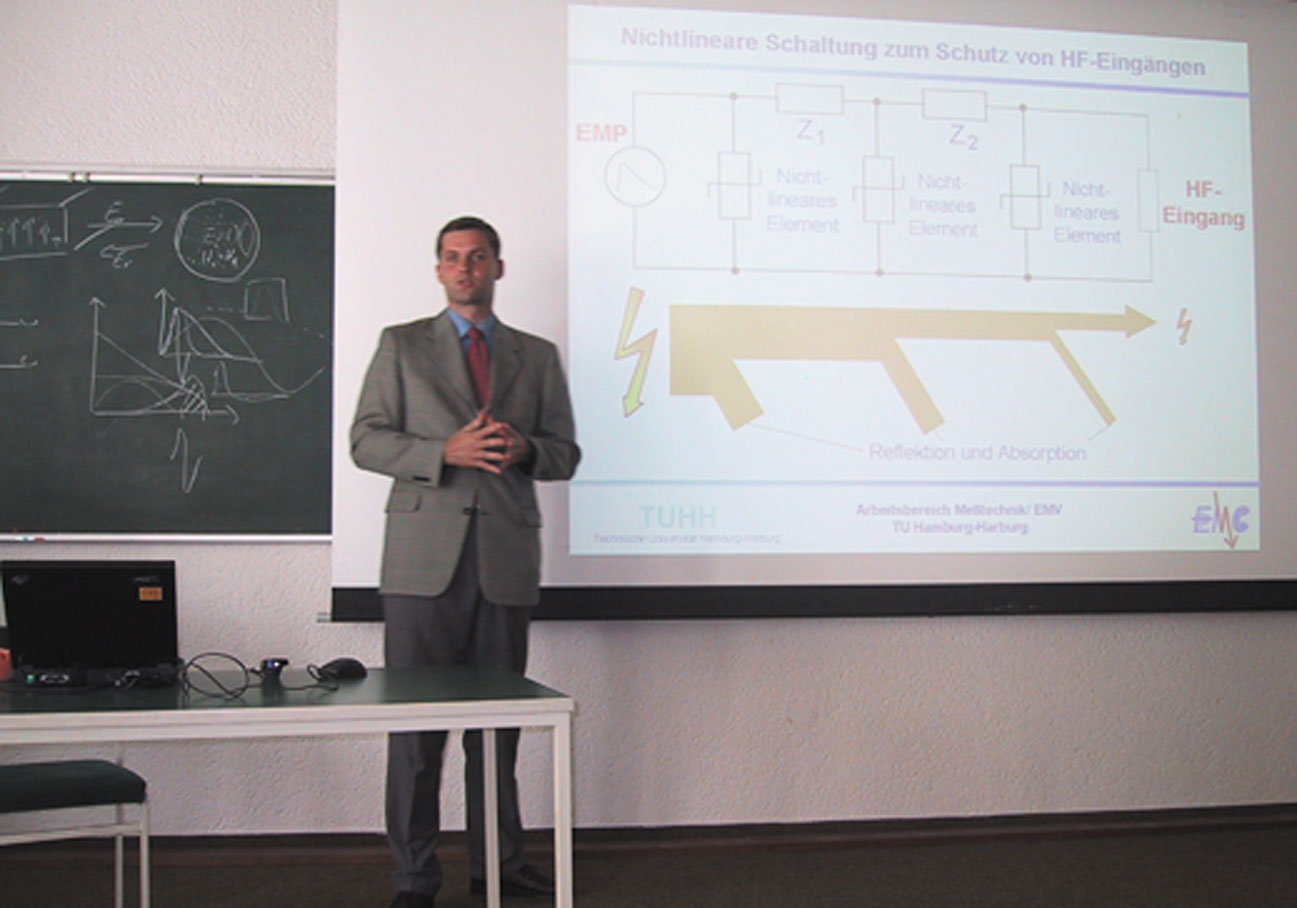 |
|
Dr. Sabath, organizer of the German EMC Chapter workshop, was pleased by the large number of participants. Please note the invitation to the 2002 workshop on EME. |
Tomas Weber of the Technical University of Hamburg-Harburg explains the protection against fast transient (UWB) signals at the German EMC Chapter meeting. |
|
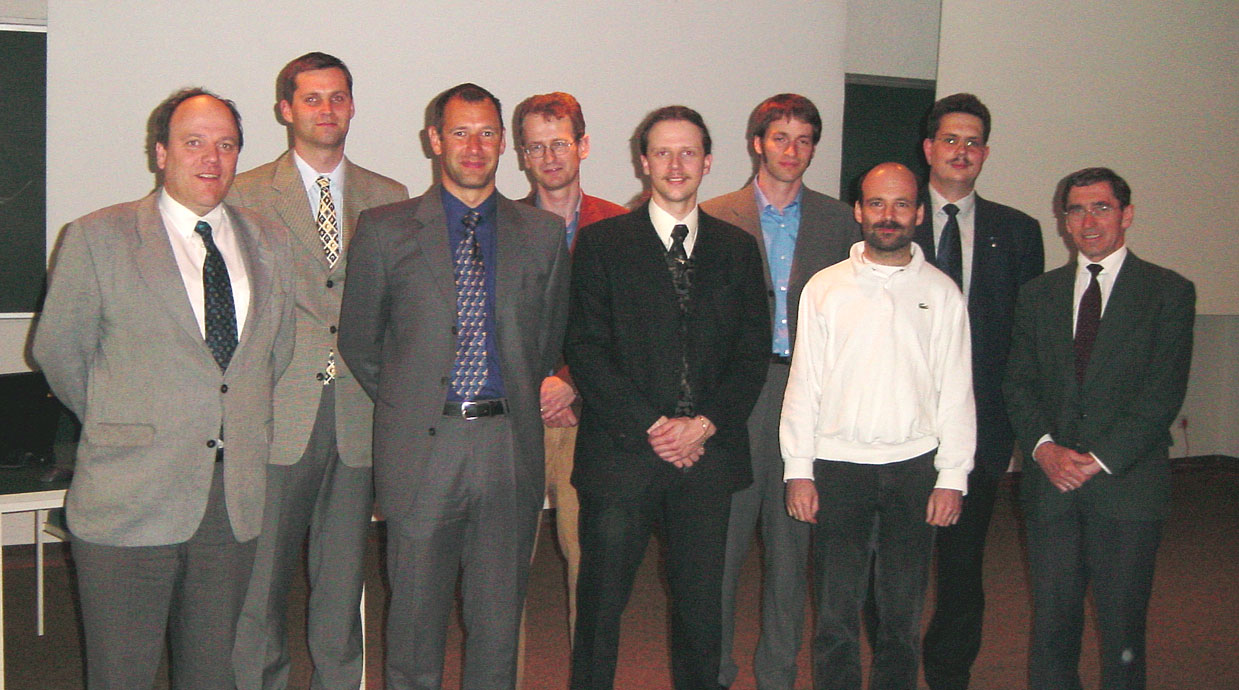 |
||
Professor Garbe, German Chapter Chairman, (far left) and Dr. Schžnzler, head of the Physics Department, (far right) welcome the speakers to the workshop. |
||
On September 24, 2001, the Israel EMC Chapter held a meeting hosted by the Israel Standard Institute (ISI) headquarters in Tel Aviv. The meeting consisted of a full day session on “EMC in General”, i.e., various EMC topics which were selected on the basis of novelty and interesting issues proposed by the Chapter members and guests. The meeting was co-sponsored by the AEAI, the Association of Engineers and Architects in Israel. Over 80 participants attended this meeting, from the high tech industry, through the military and standardization research and development institutes. Moshe Netzer, Israel EMC Chapter Chairman, gave an opening address. Next, Mr. Emil Koifman, Chairman of the Society of Electrical and Electronics Engineers in the National AEAI, addressed the attendees and invited the chapter members to take an active part in the AEAI’s third symposium scheduled for April 2002. The ten lectures which were delivered in the morning and afternoon sessions were all prepared by chapter members and guest experts and dealt with various EMC issues, including radiated susceptibility in low frequency sensors, FCC compliance of assembled components, filtering and grounding in shielded test chambers and many other topics.
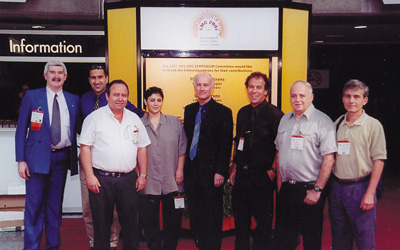 |
Members of the Israel EMC Chapter attended the Montréal Symposium and promoted the Tel-Aviv 2003 EMC Symposium, including (L-R) Elya Joffe, Oded Einat, Moshe Netzer, Vidi Bar-Natan, Shmuel Auster, Yossi Ben David, Armon Rabia, and Dr. Alex Axelrod. |
Professor Wen Xun Zhang was the presiding officer at the Nanjing Chapter’s August 27 meeting. The speaker for the meeting was Dr. Robert Marks of the National Institute of Standards and Technology in Boulder, Colorado. Dr. Marks reported on and discussed the recent activities of the IEEE 802.16 Working Group on Broadband Wireless Access Standard. A total of 145 persons were in attendance, including 23 IEEE members.
The first meeting for 2001/2002 was a joint meeting of the IEEE Central New England Chapter with the Northeast Product Safety Society (NPSS). This was held on Wednesday September 26th, 2001. The speaker was David Baron, PE, Vice President, Customer Services at Holaday Industries in Eden Prairie, Minnesota. The Speaker addressed aspects of electromagnetic field (EMF) environments relating to workplace safety. Topics included the biological basis for controlling human exposure, typical measurement units and conversions used in safety measurements, applicable standards, basic measurement procedures, and application examples of EMF’s and human perception. The presentation included frequencies from ELF (60 Hz) to RF/Microwave. 35 members and guests attended, and the speaker responded to specific questions from the audience.
Harry Gaul reports that the Phoenix Chapter did not have any meetings over the summer because they were hiding from the sun and no speakers were willing to brave the 110 degree F (43 degree C) temperatures. But the chapter has some exciting meetings planned for the future including a talk by the newly elected EMCS President, Dr. Todd Hubing, on February 13th. This talk will be held in conjunction with the EMCS Board of Directors Meeting at the Wyndham Buttes Resort in Tempe, Arizona. Then on Monday, March 11th, Dr. Clayton Paul of Mercer University in Georgia will provide a one-day tutorial on the “Fundamentals of EMC.” This tutorial will include a Table Top show with representation by many of the vendors of EMC test equipment and design components. Check out the Phoenix web site at https://www.ewh.ieee.org/r6/phoenix/phoenixemc/ for the latest schedule on upcoming meetings.
The Rocky Mountain Chapter met on September 19 at the Radisson Hotel in Northglenn, Colorado. They enjoyed a presentation by Dr. Tom Van Doren, Professor of Electrical and Computer Engineering, University of Missouri-Rolla, entitled: “Techniques for Solving EMC Problems in Various Industries.” Dr Van Doren drew upon his extensive experience and discussed five EMC problems from four different industries. Before getting into the specifics of the problems, Dr. Van Doren first reviewed the four noise coupling mechanisms that plague EMC engineers: Conducted, Magnetic Field, Electric Field and Electromagnetic Wave - and presented simple equivalent circuits to describe them. Dr. Van Doren then reviewed some of the causes of electromagnetic interference problems, including unintended current paths, poor field containment, resonance, and impedance imbalance. Dr. Van Doren then held up a small hand-held PC as an example of a radiated emissions problem at 400 MHz. He described the problem and the solution. Some spirited discussions about alternative fixes then ensued to the benefit of all. Dr. Van Doren’s next example was a temperature controller that had a susceptibility problem at the ’blazing’ frequency of 60Hz. Using simple math, Dr. Van Doren led us on a step-by-step approach on the solution of the noise issue. He then changed gears once again and we went from solving problems with fairly unsophisticated equipment to avionics gear. We examined the RF susceptibility of a flight controller. Interestingly enough, the controller actually had EMC protection added but Dr. Van Doren showed the weakness in the implementation that allowed the RF to penetrate the electronics. From flying high to wheels, Dr. Van Doren then displayed an automotive pressure sensor. This problem featured a “hidden” circuit element that allowed the rectified RF to shift a DC level, with unpleasant results. Also from the automotive worlds, Tom showed us a timing sensor that had self-induced noise. In summary, Dr. Van Doren demonstrated that even though the industry might be different, the physics of EMC coupling could be understood. This presentation is available for download at the RMC Chapter web site: https://www.ieee.org/rmcemc/
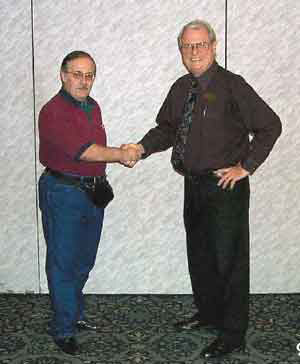 |
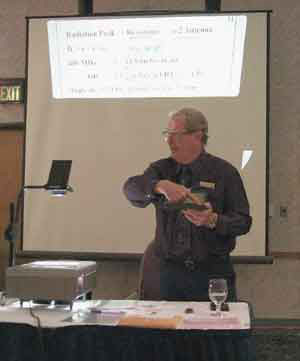 |
 |
Dr. Tom Van Doren (right) is greeted by Charles Grasso, Vice Chairman of the Rocky Mountain EMC Chapter. |
Dr. Van Doren explains a case study during his EMC problem solving presentation. |
Dr. Van Doren begins his presentation on EMC problem solving techniques. |
The newly formed Singapore chapter held its very first meeting on September 7, 2001. Since Mark Montrose and Elya Joffe were in Singapore for business, the chapter took this rare opportunity to invite both of them to present two short talks for the chapter meeting. Although the talks were arranged with very short notice, the committee was pleasantly surprised with a crowd of about 50 members and guests. The meeting started with Mr. Joffe’s talk entitled “Electrophobia, or Why Are People So Scared of Electromagnetic Fields?” His humorous style and numerous colorful slides made the serious topic both thought-provoking and interesting. After that, Mr. Montrose captured the audience’s attention with his talk on “Decoupling, Bypassing and Buried Capacitance for Enhancing PCB Performance.” The mechanism of EMI radiation from high-speed digital devices was discussed as well as the future direction of PCB designs, including special dielectric materials. The members and guests enjoyed a wonderful evening with the two distinguished speakers. The chapter would like to thank Mr. Montrose and Mr. Joffe for accepting the invitation to give the talks despite their busy schedules in Singapore. The chapter would also like to acknowledge CET Technologies for sponsoring the meeting venue and providing the refreshments.
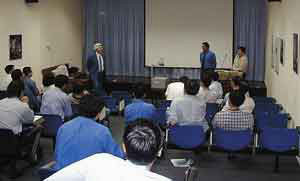 |
 |
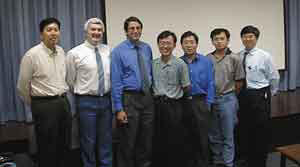 |
Mark Montrose and Elya Joffe answering the questions raised by the audience during the Q & A session. |
Elya delivered his talk on “Electrophobia” to a crowd of fifty members and guests in a seminar room at CET Technologies. This marked the first meeting of the newly formed Singapore EMC Chapter. |
Singapore EMC Chapter committee members and the September meeting speakers including (L-R) Kye-Yak See (Chair), Elya Joffe and Mark Montrose (speakers) Wee-Sing Chow (Treasurer), Er-Ping Lee (Deputy Chair), Roger Tay (committee member) and Timothy Foo (Secretary). |
The Seattle EMC Chapter held its first chapter meeting of the 2001/2002 technical program year on September 25 at AT&T Wireless in Redmond. The “boys of summer”, that is, speakers Joel Lachance of Microsoft and Ed Blankenship of Hewlett-Packard in Vancouver, did a great job with a “double-header” presentation. Joel spoke about “Strategies to Improve Confidence in Immunity Testing Under CISPR 24” while Ed spoke about “Field Perturbations Due to Accessories Used in Radiated Emission Tests.” These papers were each previously presented at the IEEE EMC Symposium in Montréal this past August. Ed’s paper was a candidate for the Best Paper Award. It’s interesting to note that Joel was born in Montréal. He started his career in medical electronic product development where he was introduced to the world of EMC. He then joined Matrox Electronics Systems in Montréal as a Compliance Engineer. Thus, he knew the Chairman of the Montréal Symposium, Benoît Nadeau, from their days together at Matrox. Joel later moved to the USA and worked for Gateway Computer and then Microsoft where he currently leads the EMC and Safety Compliance activities for the hardware peripheral development. Joel advised that CISPR 24 documents procedures to assess the performance of Information Technology Equipment (ITE) while subjected to various continuous and transient, conducted and radiated disturbances such as Electrostatic Discharges (ESD) and Electrical Fast Transient and burst (EFT/B). Basic EMC standards listed in CISPR 24 have not proven to be highly repeatable and reproducible. Therefore, this has made practical design decisions to improve ITE products performance to the standards difficult. His presentation proposed strategies that could be used to increase the confidence in the EMC basic standards called out in CISPR 24. These strategies included proper test planning, calibration and verification, repeatability and reproducibility studies, precise diagnostics and the application of a statistical process. Speaker Ed Blankenship has been employed by Hewlett Packard for 23 years in a variety of positions at three different sites. Currently, he is a senior EMC Technician in Bob Dockey’s EMC Laboratory at HP, Vancouver. He is also an Assistant Adjunct Professor of Physics at the University of Portland, Oregon’s premier Catholic University. And, he is currently Chairman of the Oregon and SW Washington EMC Chapter! Ed’s presentation included great graphics and photos, including one of a polystyrene workbench that his lab created to study the effects of field perturbations in radiated emission tests due to such accessories. It was a treat to have these excellent speakers share their papers with those of us who did not get a chance to sit in on their presentations in Montréal. Many chapter members were eager and alert that night too judging by the frequent and excellent questions posed to the speakers. It was a great way to start the year with a chapter meeting attended by over 30 people. In October, the chapter will hold a four-hour “Design and Test for Immunity Workshop” presented by Chris Kendall, Principal EMC Consultant, CKC Laboratories, Inc. In November, Franz Gisin, of Sanmina in San Jose, California returns to the chapter to present “How to Div, Grad, Kink and Curl Electrons Into Generating Unwanted Radiated Emissions.”
 |
|
A great turn out for the “double-header” presentation at the September Seattle EMC Chapter meeting at AT&T Wireless. |
It’s a line up of Seattle EMC Chapter Officers, including (from left) immediate past Chairman, Ghery Pettit of Intel, Janet O’Neil of ETS- Lindgren, the current Chair, Stephen Stimac of Cascade Engineering Services, Secretary, Kitty Tam of Microsoft, Treasurer, and Pat Andre of CKC Labs, Vice-Chairman. |
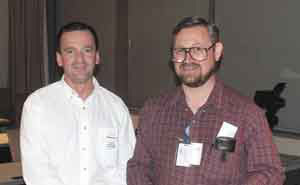 |
|
Speakers at the September Seattle EMC Chapter meeting
|
William M. Ashe of Eaton Corporation reports that the SE Michigan Chapter held a meeting on September 4, 2001 at the Defiance Corporation, who hosted the meeting and provided a pizza dinner. Val Liepa, PhD, of the University of Michigan Radiation Laboratory, presented “Modern Automobiles and FCC.” The meeting was well attended by 27 chapter members and guests. Dr. Liepa discussed the FCC requirements for transmitters and their impact on automotive systems. He discussed a number of different requirements in FCC Part 15. He also discussed their implications on data communication and RADAR imaging. The requirements that FCC lays out for transmitter bandwidths especially in the higher frequencies creates challenges to the system designer to get enough bandwidth to accurately image objects. Some examples of current technology that used clever schemes to achieve image integrity were discussed. The talk was of general interest to the EMC design community, but presented interesting challenges to the EMC testing community. Accurate testing of the very high frequencies being used in some vehicle radar designs (77 GHz) will present many challenges to the testing community. A general discussion after the formal presentation highlighted these issues. EMC
© Copyright 2001, IEEE. Terms
& Conditions. Privacy
& Security